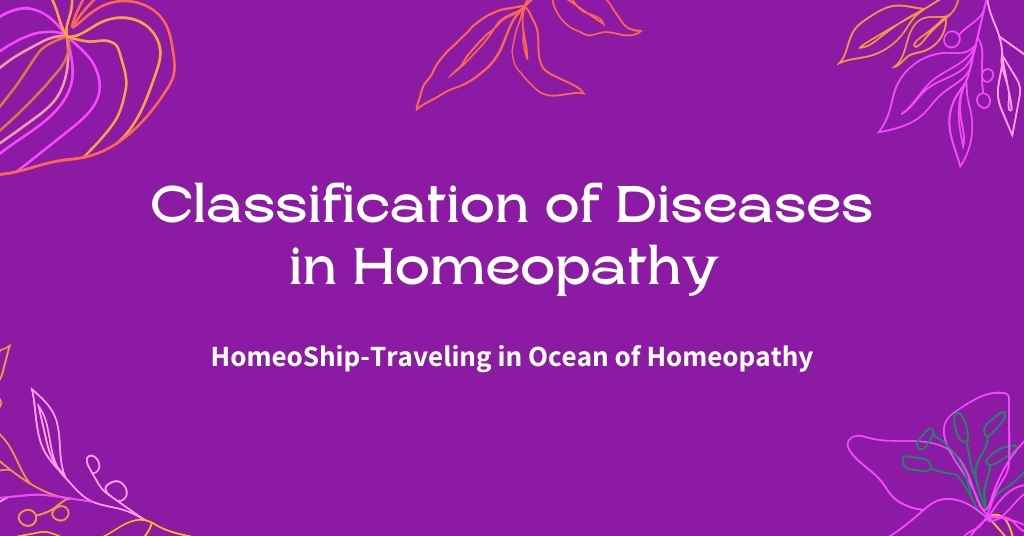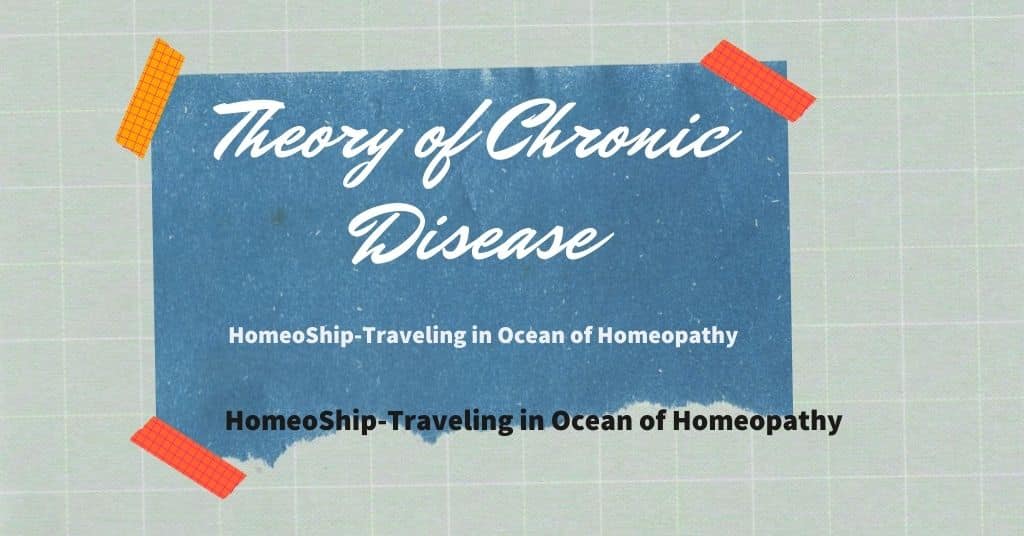Contents
During the Hahnemann period, medical practice was in chaotic condition. To make more clear Hahnemann constituted the clinical classification of diseases. Hahnemann believed in the dynamic origin of the disease and could not accept the nosological classification of the diseases. He advocated direct and immediate observation of the patient as the individual, and disease for him was an individual entity.
Disease for Hahnemann is the deviated state of health of an individual which was expressed by the vital force through perceptible signs and symptoms. So the mission of the physician is to study this individual’s response to the stimulus by the miasms.

Hahnemann broadly divided the diseases into
1. Indisposition (footnote to § 7 and 150)
2. Surgical diseases
3. Dynamic diseases
1. Indisposition
Indisposition is a slight alteration in the state of health manifested by one or more trivial symptoms that have been observed only for a short time. This is not a fully developed disease, hence does not require medicinal aid. A slight alteration in the diet and regimen is sufficient to control it. Indisposition should not be considered the disease. It can be controlled by the vital force itself, which Hippocrates also termed as the Vis medicatrix naturae. (For further elaboration go What is Indisposition? Acute vs Chronic )
2. Surgical Diseases
In § 13 and 29, Hahnemann made it clear that the surgical diseases do not come into the scope of homeopathy as they are not dynamic or miasmatic in origin, they have to be treated only by mechanical or surgical means.
Example:
The conditions like fractures of the bones, accidental cases where extensive tissue damage has occurred, etc have no dynamic causes to be treated. Instead, in such cases, the problem is purely a mechanical trauma. It is not a disease because of dynamic disturbance but a discontinuity of the anatomical tissues due to mechanical trauma.
In such cases just by administering the dynamic medicines, we cannot control the suffering. Instead, local measures like appropriating the bones and applying proper bandages, sutures, and dressings can recover the patient along with the dynamic medicines. So such cases which are not dynamic but mechanical in origin and require mechanical aid along with the dynamic homeopathic medicines, Hahnemann called as the pure surgical diseases.
3. Dynamic Diseases
Dynamic diseases can be divided into 2 types (§72):
i. Acute diseases
ii. Chronic diseases
i. Acute diseases (§72 & 73)
Acute diseases are diseases that start with sudden onset, more or less fixed course of duration and end in death or recovery with or without treatment. Acute diseases are due to acute miasms. In acute diseases, the change in the vital force is more or less superficial, in comparison to chronic diseases. Hence in such diseases, vital force to some extent can set right the disturbance on its own with or without treatment.
H.A.Roberts says, “In acute manifestations the vital functions are often restored to complete harmony by and through their own power.”
Kent says “Acute miasm is the one that comes upon the economy, passes through its regular prodromal period, longer or shorter, has its period of progress and period of decline, and in which there is a tendency to recovery.”
In acute diseases, the disturbance first starts on the superficial parts of the body and then spreads to the inner life force. Hence, in acute diseases, tissue damage dominates the constitutional symptoms. The pathological inflammatory changes are reversible in most acute diseases, hence complete recovery is possible. In acute diseases, we always can find some exciting causes.
These exciting causes will lead to the transient explosion of latent psora. So in short, acute diseases are sudden and violent in onset, rapid or moderately speedy course, finish their course more or less rapidly and terminate into death or recovery.
In acute diseases, the symptoms evolve rapidly and the symptoms are easily found. So the treatment of acute disease is easy. It requires the usage of common acute short-acting remedies.
Kent says, “treat the acute conditions even in the chronic case first”. During the treatment, the symptoms of the recent acute symptoms should not be mixed up with the constitutional symptoms of the chronic disease. Only the freshly developed symptoms of the acute origin have to be taken into consideration.

Types of acute diseases
Acute diseases are of 3 types:
a. Individual
b. Sporadic
c. Epidemic
a. Individual diseases
(individuaous = not divisible/ single):
This is a type of disease that attacks humans individually due to some exciting cause of mental or physical origin. Example: excessive intake of food or deficient supply of it, severe chill, overheating, strain, mental emotions, etc act as an exciting cause to develop individual acute diseases. Different people at different places can suffer from individual diseases at different or the same time.
Example: Ram may suffer from diarrhea in Chennai; Krishna may be suffering from headaches in Mumbai etc at the same time. This acute disease is nothing but a transient explosion of the latent psora. If this is not of a violent character, the psora goes into the latent stage on its own, and the patient recovers. But this recovery is done at cost of some damage to the patient’s vitality, which makes him more susceptible to the diseases. Without the medicine, the individual disease will result in death or recovery. This disease can be treated with homeopathic remedies based on acute totality.
b. Sporadic diseases:
These are the type of acute diseases that attack several persons at the same time here and there, by means of meteoric, telluric, and injurious agents or influences. The exciting cause, in this case, maybe either climatic influences, atmospheric or physical agents (meteoric), or influences in the soil, water (telluric), etc. These causes will affect only a few persons with identical susceptibilities.
Example: A group of people is affected with a type of fever in Chennai; at the same time a group is suffering from headaches in the same place. Sporadic disease, like any other acute disease, is because of the explosion of latent psora, and this can be treated with homeopathic medicines. Every sporadic disease must be considered as a new one at every incidence and treated based on the totality only.
c. Epidemic diseases
(Greek word; epi= upon, demos= people/ epidemic=upon the people): Epidemic diseases are the type of acute diseases that affect many persons, with very similar sufferings from the same cause. Hahnemann uses the word infectious, in this context, because the epidemic disease becomes infectious when it spreads among the thickly populated areas. Each and every epidemic is a peculiar one, though seemingly they have identical origins. Like any other acute disease, when left to the vital force they terminate either in death or recovery of the patient. The cause of the epidemic diseases may be due to Calamities of war or floods (inundations), famines, etc.
Acute miasms that cause acute diseases may be of 2 types:
Recurrent acute miasm:
These miasms recur in the same manner more than once in the lifetime of a person. Example: a plague of the Levant, Asiatic cholera, the yellow fever of the sea coast, etc.
Non-recurrent acute miasm:
This is also called the fixed miasm. This attacks several persons only once in a lifetime. Example: smallpox, whooping cough, etc.
So we are ending it up here but the classification of disease isn’t must read the chronic disease classification.



Does your blog have a contact page? I’m having a tough time locating it but, I’d like to send you an e-mail. I’ve got some ideas for your blog you might be interested in hearing. Either way, great site and I look forward to seeing it grow over time.
Yes please feel free to contact at [email protected]